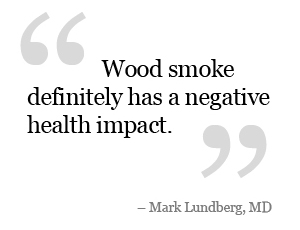Greenhouse Gases from Wood are a Burning Issue
The International Panel on Climate Change (IPCC) has proven that particles created by burning wood and other biomass—so called “black carbon”—are a major contributor to global warming.
Just like coal, oil, and natural gas, the greenhouse gases (GHGs) sequestered in wood are released to the atmosphere when we burn it for fuel and heat. But while there is agreement that burning wood releases GHGs and creates black carbon, some argue that wood burning is “carbon neutral” because it releases about the same amount of GHGs that is released when a tree decays naturally.
Technically this is true; however, it’s important to consider the factor of time as it relates to burning vs. decaying. It takes over 15 years for a typical tree used for wood burning to mature before it is harvested. During that time, the tree is storing CO2 that it collects from the atmosphere. Given the opportunity, that tree could live for another hundred years or more, continuing to collect and store GHGs. After it dies naturally, it will take many more years for it to decay and gradually release the GHGs it collected over its lifespan. However, if the tree is burned in a fireplace or woodstove, all those GHGs are released in just a few hours and in higher concentrations.
This difference in timescale is critical. The IPCC has developed a set of projections for the dire effects of climate change. Their report presents a range of scenarios based on how quickly we can reduce our GHG production and how fast we can lower the concentrations of GHGs already in our atmosphere. Many scientists believe that reducing or eliminating wood and other biomass burning to be one of the easiest and most effective ways for us to curb global warming.
The need to reduce deforestation in places like the Amazon and Africa, and in fact the need to plant MORE trees to sequester CO2 and other GHGs, has long been known. But we also need to make the connection to wood burning in our homes here in North America. If we immediately reduce our reliance on wood for heat and break our habit of burning wood for ambiance, we can make a significant contribution to reducing GHGs and black carbon and help avoid some of the most extreme effects of climate change that are predicted by the IPCC.




